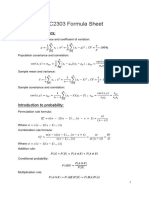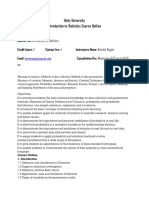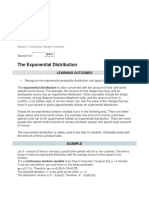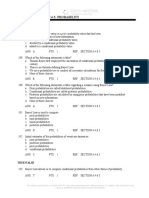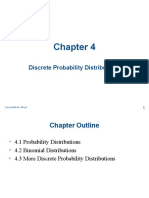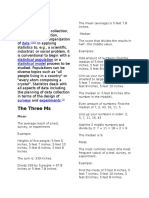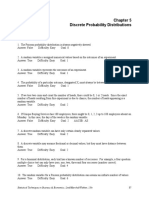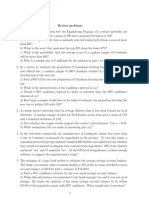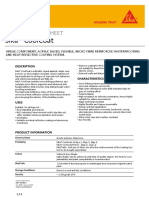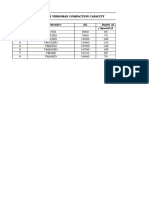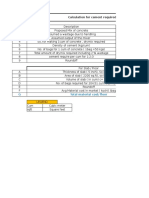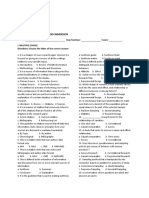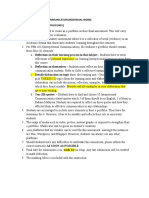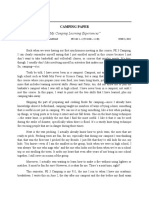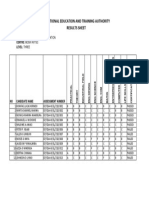Important Statistics Formulas
This web page presents statistics formulas described in the Stat Trek tutorials. Each formula links to a
web page that explains how to use the formula.
Parameters
Population mean = = ( Xi ) / N
Population standard deviation = = sqrt [ ( X i - )2 / N ]
Population variance = 2 = ( Xi - )2 / N
Variance of population proportion = P2 = PQ / n
Standardized score = Z = (X - ) /
Population correlation coefficient = = [ 1 / N ] * { [ (X i - X) / x ] * [ (Yi - Y) / y ] }
Statistics
Unless otherwise noted, these formulas assume simple random sampling.
Sample mean = x = ( xi ) / n
Sample standard deviation = s = sqrt [ ( x i - x )2 / ( n - 1 ) ]
Sample variance = s2 = ( xi - x )2 / ( n - 1 )
Variance of sample proportion = s p2 = pq / (n - 1)
Pooled sample proportion = p = (p1 * n1 + p2 * n2) / (n1 + n2)
Pooled sample standard deviation = sp = sqrt [ (n1 - 1) * s12 + (n2 - 1) * s22 ] / (n1 + n2 - 2) ]
Sample correlation coefficient = r = [ 1 / (n - 1) ] * { [ (x i - x) / sx ] * [ (yi - y) / sy ] }
Correlation
Pearson product-moment correlation = r = (xy) / sqrt [ ( x 2 ) * ( y2 ) ]
Linear correlation (sample data) = r = [ 1 / (n - 1) ] * { [ (x i - x) / sx ] * [ (yi - y) / sy ] }
Linear correlation (population data) = = [ 1 / N ] * { [ (X i - X) / x ] * [ (Yi - Y) / y ] }
Simple Linear Regression
Simple linear regression line: = b 0 + b1x
Regression coefficient = b1 = [ (xi - x) (yi - y) ] / [ (xi - x)2]
Regression slope intercept = b0 = y - b1 * x
Regression coefficient = b1 = r * (sy / sx)
Standard error of regression slope = s b1 = sqrt [ (yi - i)2 / (n - 2) ] / sqrt [ (xi - x)2 ]
Counting
n factorial: n! = n * (n-1) * (n - 2) * . . . * 3 * 2 * 1. By convention, 0! = 1.
Permutations of n things, taken r at a time: nPr = n! / (n - r)!
Combinations of n things, taken r at a time: nCr = n! / r!(n - r)! = nPr / r!
Probability
Rule of addition: P(A B) = P(A) + P(B) - P(A B)
Rule of multiplication: P(A B) = P(A) P(B|A)
Rule of subtraction: P(A') = 1 - P(A)
Random Variables
In the following formulas, X and Y are random variables, and a and b are constants.
Expected value of X = E(X) = x = [ xi * P(xi) ]
Variance of X = Var(X) = 2 = [ xi - E(x) ]2 * P(xi) = [ xi - x ]2 * P(xi)
Normal random variable = z-score = z = (X - )/
Chi-square statistic = 2 = [ ( n - 1 ) * s2 ] / 2
f statistic = f = [ s12/12 ] / [ s22/22 ]
Expected value of sum of random variables = E(X + Y) = E(X) + E(Y)
Expected value of difference between random variables = E(X - Y) = E(X) - E(Y)
Variance of the sum of independent random variables = Var(X + Y) = Var(X) + Var(Y)
Variance of the difference between independent random variables = Var(X - Y) = Var(X) + Var(Y)
Sampling Distributions
Mean of sampling distribution of the mean = x =
Mean of sampling distribution of the proportion = p = P
Standard deviation of proportion = p = sqrt[ P * (1 - P)/n ] = sqrt( PQ / n )
Standard deviation of the mean = x = /sqrt(n)
Standard deviation of difference of sample means = d = sqrt[ (12 / n1) + (22 / n2) ]
Standard deviation of difference of sample proportions = d = sqrt{ [P1(1 - P1) / n1] + [P2(1 - P2) /
n2 ] }
Standard Error
Standard error of proportion = SE p = sp = sqrt[ p * (1 - p)/n ] = sqrt( pq / n )
Standard error of difference for proportions = SE p = sp = sqrt{ p * ( 1 - p ) * [ (1/n1) + (1/n2) ] }
Standard error of the mean = SE x = sx = s/sqrt(n)
Standard error of difference of sample means = SE d = sd = sqrt[ (s12 / n1) + (s22 / n2) ]
Standard error of difference of paired sample means = SE d = sd = { sqrt [ ((di - d)2 / (n - 1) ] } /
sqrt(n)
Pooled sample standard error = s pooled = sqrt [ (n1 - 1) * s12 + (n2 - 1) * s22 ] / (n1 + n2 - 2) ]
Standard error of difference of sample proportions = s d = sqrt{ [p1(1 - p1) / n1] + [p2(1 - p2) / n2] }
Discrete Probability Distributions
Binomial formula: P(X = x) = b(x; n, P) = nCx * Px * (1 - P)n - x = nCx * Px * Qn - x
Mean of binomial distribution = x = n * P
Variance of binomial distribution = x2 = n * P * ( 1 - P )
Negative Binomial formula: P(X = x) = b*( x; r, P) =
Mean of negative binomial distribution = x = rQ / P
Variance of negative binomial distribution = x2 = r * Q / P2
Geometric formula: P(X = x) = g(x; P) = P * Qx - 1
Mean of geometric distribution = x = Q / P
Variance of geometric distribution = x2 = Q / P2
Hypergeometric formula: P(X = x) = h( x; N, n, k) = [ kCx ] [
Mean of hypergeometric distribution = x = n * k / N
Variance of hypergeometric distribution = x2 = n * k * ( N - k ) * ( N - n ) / [ N2 * ( N - 1 ) ]
Poisson formula: P(x; ) = (e-) (x) / x!
Mean of Poisson distribution = x =
Variance of Poisson distribution = x2 =
Multinomial formula: P = [ n! / ( n 1! * n2! * ... nk! ) ] * ( p1n1 * p2n2 * . . . * pknk )
Cr-1 * Pr * (1 - P)x - r
x-1
N-k
Cn-x ] / [ NCn ]
Linear Transformations
For the following formulas, assume that Y is a linear transformation of the random variable X, defined by
the equation: Y = aX + b.
Mean of a linear transformation = E(Y) = Y = aX + b.
Variance of a linear transformation = Var(Y) = a 2 * Var(X).
Standardized score = z = (x - x) / x.
t-score = t = (x - x) / [ s/sqrt(n) ].
�Estimation
Confidence interval: Sample statistic + Critical value * Standard error of statistic
Margin of error = (Critical value) * (Standard deviation of statistic)
Margin of error = (Critical value) * (Standard error of statistic)
Hypothesis Testing
Standardized test statistic = (Statistic - Parameter) / (Standard deviation of statistic)
One-sample z-test for proportions: z-score = z = (p - P 0) / sqrt( p * q / n )
Two-sample z-test for proportions: z-score = z = z = [ (p 1 - p2) - d ] / SE
One-sample t-test for means: t-score = t = (x - ) / SE
Two-sample t-test for means: t-score = t = [ (x 1 - x2) - d ] / SE
Matched-sample t-test for means: t-score = t = [ (x 1 - x2) - D ] / SE = (d - D) / SE
Chi-square test statistic = 2 = [ (Observed - Expected)2 / Expected ]
Degrees of Freedom
The correct formula for degrees of freedom (DF) depends on the situation (the nature of the test
statistic, the number of samples, underlying assumptions, etc.).
One-sample t-test: DF = n - 1
Two-sample t-test: DF = (s12/n1 + s22/n2)2 / { [ (s12 / n1)2 / (n1 - 1) ] + [ (s22 / n2)2 / (n2 - 1) ] }
Two-sample t-test, pooled standard error: DF = n 1 + n2 - 2
Simple linear regression, test slope: DF = n - 2
Chi-square goodness of fit test: DF = k - 1
Chi-square test for homogeneity: DF = (r - 1) * (c - 1)
Chi-square test for independence: DF = (r - 1) * (c - 1)
�Sample Size
Below, the first two formulas find the smallest sample sizes required to achieve a fixed margin of error,
using simple random sampling. The third formula assigns sample to strata, based on a proportionate
design. The fourth formula, Neyman allocation, uses stratified sampling to minimize variance, given a
fixed sample size. And the last formula, optimum allocation, uses stratified sampling to minimize
variance, given a fixed budget.
Mean (simple random sampling): n = { z 2 * 2 * [ N / (N - 1) ] } / { ME 2 + [ z2 * 2 / (N - 1) ] }
Proportion (simple random sampling): n = [ ( z 2 * p * q ) + ME2 ] / [ ME2 + z2 * p * q / N ]
Proportionate stratified sampling: nh = ( Nh / N ) * n
Neyman allocation (stratified sampling): n h = n * ( Nh * h ) / [ ( Ni * i ) ]
Optimum allocation (stratified sampling):
nh = n * [ ( Nh * h ) / sqrt( ch ) ] / [ ( Ni * i ) / sqrt( ci ) ]
Statistics Tutorial
